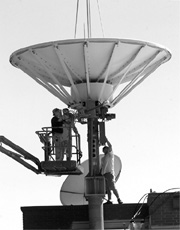
|
|
Tuning In To The CCCSAT Network
The California Community College Satellite Network (CCCSAT) delivery system is designed to be reliable, simple to operate, and maintenance free. CCCSAT’s satellite downlink system has no moving mechanical parts, is always tuned to the correct satellite and transponder, and is designed for operation by staff without specialized technical training. It is meant to be a “satellite appliance,” as easy to use as a toaster. The CCCSAT engineers have completed research that, after many years of satellite uplink and downlink experience, has revealed that the weakest link in receiving satellite programming is pointing the dish at the correct satellite. When a general-purpose, movable satellite dish (usually 10 to 15 feet in diameter) is used to receive satellite programming, it must be re-positioned to a new satellite each time a different program source is desired. The mechanics of these low cost (less than $15,000) downlink antennas cannot repeatedly return to a specific satellite with precision. The problem is compounded by their large diameter and consequently narrower beam width at the higher Ku band frequencies used by CCCSAT. Any position error will degrade the signal. This means that once the movable dish "lands" on a satellite, it must be manually adjusted by an operator to "peak" the signal strength in order to receive a clear picture. The CCCSAT satellite network has been engineered to provide broadcast quality programming using dish antennas only 1.8 meters in diameter. When these dishes are initially installed, they are set to the fixed satellite used by CCCSAT. The dishes are small enough to be mounted on almost any standard roof surface without penetrating or otherwise damaging the roof. They are very similar to the small satellite dishes you might see on the roof of a convenience store or gas station that are used for processing credit card transactions. Because these dishes are always receiving the CCCSAT signal, there will always be CCCSAT programming coming from your DigiCipher receiver. There is no need for technical staff to fine tune the signal each time the system is to be used. The CCCSAT engineering mission is to provide a broadband delivery system to serve all 107 California Community Colleges. Our goal is to provide a system that is technically simple, easy to operate, reliable, and inexpensive. We will be providing the very best picture and sound possible using today’s technology, but always keeping an eye to the future. |
||||||||||
|
||||||||||||

